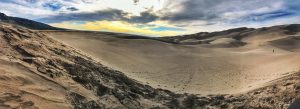GREAT SAND DUNES NATIONAL PARK – Sand rips over 300 feet tall dunes in the San Luis Valley. You look down and feel as if you’re in a desert on Mars. You look up and see jagged snowy peaks of the Sangre de Cristo Mountain Range.
Protecting this unique ecosystem in a changing future is now the challenge.
“I cannot overemphasize the value of pristine land,” said Fred Bunch, resource manager for the Great Sand Dunes National Park.
The Philanthropic Educational Organization (PEO), in the 1900s, led Alamosa and Monte Vista in protecting the nearby dunes. Valley locals were concerned about mining in the ecosystem. Initially, small mining projects filled the valley, but locals feared large conglomerations taking over and destroying the natural landscape.
The PEO wrote letters to Congress urging for the designation of the dunes as a national monument.
In 1932, President Herbert Hoover declared the dunes as a national monument. Eighty-two years later, sand dunes were established as a national park.
“These parks are America’s jewels and one of the best ideas we’ve come up with not to consume and step back and protect it for the future,” said Bunch.
The United States led the world in laws protecting natural ecosystems for sake of conserving pristine wilderness.
Today, this ecosystem is inspiring visits from all over the world.
The Great Sand Dunes have become so popular that the biggest problem facing the park is visitor congestion, said Bunch. In 2013 there were 238,000 park visitors. In 2018 the number of visitors increased to nearly 487,000. Today, park officials are trying to balance higher revenue from rising visitor numbers with the over crowing more visitors create in the park. Bunch said he is concerned that visitor experience may decrease as congestion increases.
The Sand Dune’s increased congestion is a problem many parks are facing.
The National Park System has experienced a dramatic increase in attendance, 1.5 billion visits in the past five years, reported the National Park Service (NPS) Office of Communication. In 2017 National Parks saw 330, 882, 751 visitors, just behind the record 2016 set of 330, 971, 689 visitors.
“When you look across the landscape and you can’t tell what year it is, we are accomplishing our goal,” said Bunch. Park officials, including Bunch, fear that congestion of parks may start to compromise the untouched nature of America’s national parks.
Pristine wilderness is becoming increasingly threatened as urban landscapes increase, and more Americans move closer to cities, expanding municipal borders. As more people move to major metropolises, American’s desire to visit wilderness set aside for protection is also increasing, as reflected in the recent surge of visitors to national parks.
The Great Sand Dunes is an example of the problem facing nearly all National Parks – how does America continue to protect our pristine wilderness, while still providing an escape from “The lands set aside for the future and enjoyment of the people are really critical for our health as a nation,” said Bunch.

